Not so long ago, with beneficiary waiting lists for homes and land longer than 5 p.m. shadows, the state Department of Hawaiian Home Lands moved quickly to develop residential lots for qualifying Native Hawaiians.
With today’s staggering economy, the push has also been made to be in the business of “building homeowners” as well as building homes, said Lloyd Yonenaka, DHHL spokesperson.
Case in point is the recent site-selection meeting for Anahola houses and lots, held at Chiefess Kamakahelei Middle School here earlier this month.
Where earlier in the administration of Gov. Linda Lingle the push was to fast-track preparation of lots for building of homes and getting beneficiaries on their land quickly, in order to pare dusty wait lists, the most recent site-selection meeting was scaled down, according to a DHHL press release, in order to give Native Hawaiian families more time to prepare for successful homeownership.
Where DHHL hoped to award 25 homes and 10 vacant lots, just 11 homes and five vacant lots went to beneficiaries earlier this month at the site-selection meeting.
As of last month, there were still 19,728 names on the statewide DHHL wait list for homes or land, and 1,473 names on the Kaua‘i lists, said Yonenaka, technically the DHHL Information and Community Relations Office administrator.
The most recent Kaua‘i awards are for land in Phase 1, Increment 2 of the 172-unit Pi‘ilani Mai Ke Kai residential subdivision in Anahola.
In January, the first increment of 36 lots were awarded and consisted of 26 turnkey homes and 10 vacant lots, which are currently under construction.
The project is being developed in three phases under the department’s Undivided Interest Awards program which provides a homestead lease without the need to financially qualify for a mortgage until the homes are ready for construction, usually in two to three years.
That time is used by the lessees to financially qualify for a mortgage, and by the department to build the infrastructure for the subdivision.
“This project provides affordable homes at a time when housing is out of reach for so many of Hawai‘i’s people,” said Micah Kane, chair of the state Hawaiian Homes Commission.
“Almost three years ago, we awarded these Undivided Interest homestead leases with the promise to build homes here. We also asked the people who took these leases to take this time to financially prepare to qualify for a mortgage,” Kane said.
“We have fulfilled our promise, and many who took the Undivided Interest lease have fulfilled their promise to get ready. Today (earlier this month), they are selecting their future home, and that’s exciting not just for these families, but for the entire community,” Kane said.
In the past, many lessees were offered homestead leases, but stayed on the wait list because they could not financially qualify for a home loan, he said.
Some of the families selecting homes earlier this month were not able to qualify for an adequate loan three years ago, but have used that time to work with the department’s Home Ownership Assistance Program to improve their credit, create savings, pay down debt or improve their earning capacity to qualify for a mortgage, Kane said.
“The HOAP program is really the bridge that helps an Undivided Interest lessee become a homeowner,” said Gov. Linda Lingle. “DHHL’s HOAP program is making a difference in many lives by ensuring future generations have the opportunity to grow up in a home they own, instead of a house they rent.”
The department continues to “build green,” as all homes will come equipped with solar water heating systems, low-flow plumbing fixtures, energy-efficient compact fluorescent light bulbs, energy-star appliances, and double-E-rated windows and sliding doors for added insulation.
“Our Hawaiian Homes Commission just adopted an energy policy that recognizes the importance of energy efficiency and using renewable/clean energy, as well as respecting our environment,” said Kane.
“Moving away from imported foreign oil and increasing Hawai‘i’s energy independence is the priority focus of the Lingle-Aiona Administration’s Hawai‘i Clean Energy Initiative,” Kane said.
“Providing our beneficiaries with energy-efficient homes will reduce the cost of living and make this project not only affordable to own, but more affordable to live in too.”
Coastal Construction is the home-building contractor for the first phase. Four models, ranging from three-bedroom, two-bath Aheahe model with 1,056 square feet at $201,000, to the four-bedroom, two-bath Malua model with 1,539 square feet of living space at $260,000 are being offered.
The Pi‘ilani Mai Ke Kai subdivision is approximately 71 acres. Although the subdivision has 172 lots with a minimum size of 10,000 square feet, two lots are part of previously undeveloped awards included in the 1985-1986 Acceleration of Awards program.
Cost of on-site improvements for Phase 1 is $9.03 million, which was funded from two sources: Hawaiian Home Land Trust Fund ($5.83 million) and Native Hawaiian Housing Block Grant ($3.20 million). Delta Construction was the contractor for the on-site improvements.
For more information, visit www.dhhl.hawaii.gov.





